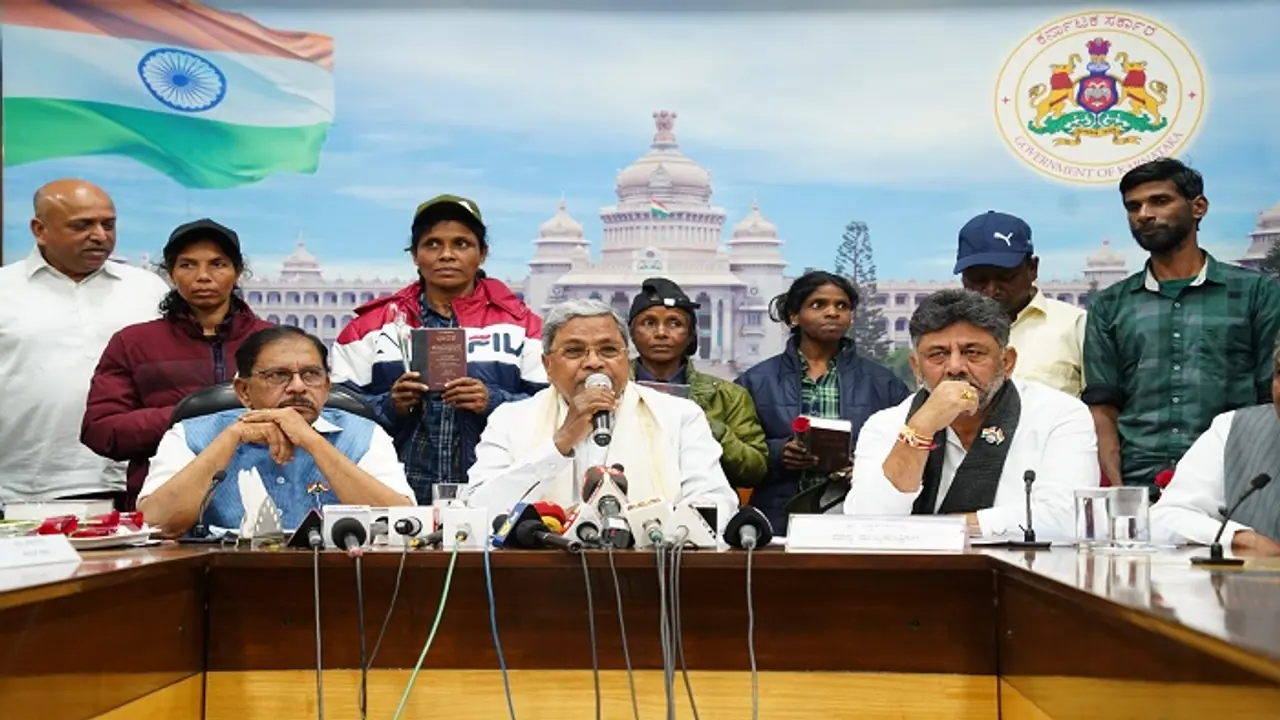Six Naxalites, involved in decades of armed activities across Karnataka, Kerala, and Tamil Nadu, surrendered before Karnataka CM Siddaramaiah. The group, including leader Mundagaru Latha, responded to rehabilitation efforts and pledged to rejoin society, marking a significant milestone in ending regional unrest.
Six Naxalites, who had been actively involved in armed struggles across Karnataka, Kerala, and Tamil Nadu for over two decades, surrendered before Karnataka Chief Minister Siddaramaiah on Wednesday evening. This marks the first instance in the state's history where Naxalites have laid down arms in the presence of a sitting Chief Minister.

The surrender occurred at the Chief Minister's home office, where Siddaramaiah welcomed the six individuals into the mainstream by offering them a copy of the Indian Constitution and a rose. This symbolic gesture was part of an effort to integrate them into society and end their involvement in armed conflict.
In November 2024, following the encounter of prominent Naxal leader Vikram Gowda, Chief Minister Siddaramaiah appealed to Naxalites operating in Karnataka to abandon violence and surrender. Subsequently, the Naxal Rehabilitation Committee and the Citizens’ Forum for Peace initiated discussions with active members of the Naxal movement. They engaged with individuals in forested regions of Shivamogga, Chikkamagaluru, Dakshina Kannada, and other districts, urging them to return to the mainstream.
As a result of these efforts, six Naxalites, including well-known leader Mundagaru Latha, agreed to surrender. They arrived at the Chief Minister's office on Wednesday at 6 PM, marking the culmination of months of dialogue and trust-building.
1. Mundagaru Latha
Hailing from Mundagaru village in Sringeri taluk, Chikkamagaluru district, Latha comes from a large family. She discontinued her studies during her Pre-University Course at JCBM College in Sringeri and became a key figure in the anti-Naxal Kudremukh National Park movement. Her leadership later extended to armed Naxal activities.
2. Sundari Kuthlur
A native of Kuthlur village in Dakshina Kannada district, Sundari dropped out of school in the 3rd standard due to poverty and lack of access to education. Facing displacement threats from the Kudremukh National Park project, Sundari took up arms in 2004 after realising that democratic protests were not yielding results.
3. Vanajakshi
From Balehole village near Kalasa, Vanajakshi ended her formal education after completing SSLC. She was elected unopposed to the Balehole Gram Panchayat in 1992 and 1997. Her family lost their land during the Baladya displacement, which led to her mother’s suicide. Vanajakshi joined the Maoist movement in 2000.
4. Jayanna Aroli
Jayanna, a Dalit youth from Aroli village in Manvi taluk, Raichur district, was influenced by Maoist ideology while pursuing his education. He joined the armed movement in 2000 at the age of 24, after being deeply affected by Bhaskar’s encounter. He rejoined the Naxal struggle in 2018.
5. K. Vasanth
A resident of Arcot in Tamil Nadu's Vellore district, Vasanth holds a B.Tech degree. Influenced by social struggles from an early age, he joined the Naxal movement in Karnataka after graduating in 2010. Known for his moderate language, Vasanth has chosen to transition to the mainstream while maintaining his ideals.
6. M.D. Jisha
Jisha, the youngest of the group, is an Adivasi woman from Makkimala in Kerala's Wayanad district. Having studied only up to class 8, Jisha joined the armed struggle in Kerala in 2018. She later moved across states and arrived in Karnataka with her comrades in 2023 before surrendering.
The Karnataka government, in coordination with rehabilitation committees and civil society groups, has promised to provide support and resources for the surrendered individuals to reintegrate into society.
